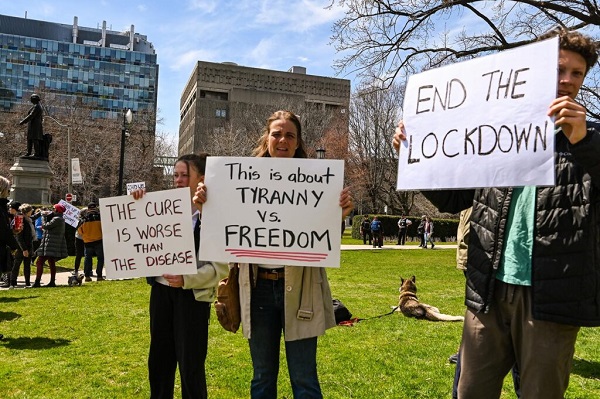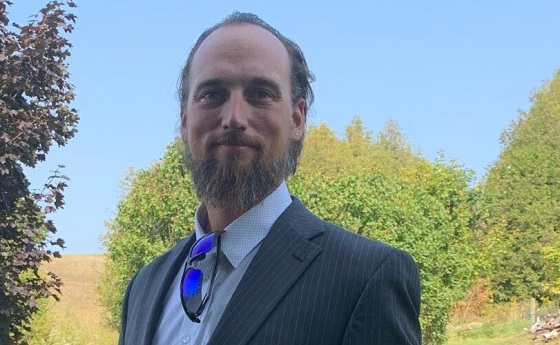COVID-19
Saskatchewan protestors ask Supreme Court to hear their challenge to gathering restrictions

News release from the Justice Centre for Constitutional Freedoms
The Justice Centre for Constitutional Freedoms announces that Jasmin Grandel and Darrell Mills intend to take their constitutional challenge to Saskatchewan’s Covid gathering restrictions to the Supreme Court of Canada. On May 15, 2024, the Saskatchewan Court of Appeal dismissed their case. Today, our lawyers applied for leave to appeal their case to Canada’s highest court in a potentially precedent-setting case about the freedom of peaceful assembly.
On December 19, 2020, Ms. Grandel and Mr. Mills participated in a peaceful protest against the Government of Saskatchewan’s Covid lockdown measures at the Vimy Memorial in Saskatoon’s Kiwanis Park. Police ticketed them for attending a protest exceeding Saskatchewan’s 10-person outdoor gathering limit.
Jasmin Grandel, a young mother, attended peaceful protests to express her concerns about the lack of transparency surrounding government restrictions. She was especially concerned about the requirement that her son wear a mask in kindergarten.
Darrell Mills, certified in Mask Fit Testing and trained in supplied air breathing systems, also attended peaceful demonstrations to voice his concerns about improper mask usage and the significant burdens mask mandates placed on persons with physical or psychological conditions.
On April 7, 2021, our lawyers filed a constitutional challenge to these gathering restrictions at the Saskatoon Court of Queen’s Bench on behalf of Ms. Grandel and Mr. Mills. They argued that the gathering restrictions violated their freedoms of expression, peaceful assembly, and association – protected by the Canadian Charter of Rights and Freedoms. That challenge was heard by the Court on June 29, 2022.
Unfortunately, while it was conceded that the gathering restrictions did limit their freedom of expression, the Court ruled that the limitation was justified. Further, the Court found that, because the limitation on freedom of expression was justified, the limitations on the freedoms of peaceful assembly and association were also justified without the need for independent analysis of those rights.
Ms. Grandel and Mr. Mills were not deterred, appealing that decision on August 14, 2023. In yet another setback, however, their appeal was dismissed on May 15, 2024, by the Court of Appeal for Saskatchewan in a unanimous decision upholding the lower Court’s findings.
They are now asking the Supreme Court of Canada to hear their case. On August 14, 2024, our lawyers filed a Notice of Application for Leave to Appeal to the Supreme Court. If granted, they will argue that Saskatchewan’s Covid gathering restrictions were primarily an unjustifiable limitation of the freedom of peaceful assembly, which was not centrally considered. The Supreme Court has an opportunity to develop a more robust legal framework for addressing limitations to that freedom.
Our lawyers argue that, in many cases where the government has violated multiple Charter freedoms, particularly the freedoms of expression, assembly and association, courts tend to focus on limitations to freedom of expression only. In other words, courts tend to find an independent analysis of violations of other rights unnecessary. If a court finds that the government justifiably limited freedom of expression, they tend to find that the government justifiably limited the freedom of peaceful assembly if it were to have been infringed.
Canadian courts ought to develop a test for addressing violations to the freedom of peaceful assembly. Today, two Saskatchewan citizens have asked the Supreme Court to develop such a test and to apply it to gathering restrictions that impacted more than a million residents. If this case is heard by the Supreme Court, it could have a profound impact on the fundamental freedoms of Canadians.
Lawyer Andre Memauri says, “Our request for leave to appeal in this matter seeks to address concerns with how Charter violations are addressed within the section 1 analysis, when numerous Charter violations are engaged. Additionally, there exists a void in jurisprudence with respect to a test in how to address the guarantee of peaceful assembly directly, and we are hoping the Supreme Court of Canada provides guidance on this increasingly important matter to Canadians.”
COVID-19
Judge denies Canadian gov’t request to take away Freedom Convoy leader’s truck

From LifeSiteNews
A judge ruled that the Ontario Court of Justice is already ‘satisfied’ with Chris Barber’s sentence and taking away his very livelihood would be ‘disproportionate.’
A Canadian judge has dismissed a demand from Canadian government lawyers to seize Freedom Convoy leader Chris Barber’s “Big Red” semi-truck.
On Friday, Ontario Court of Justice Judge Heather Perkins-McVey denied the Crown’s application seeking to forfeit Barber’s truck.
She ruled that the court is already “satisfied” with Barber’s sentence and taking away his very livelihood would be “disproportionate.”
“This truck is my livelihood,” said Barber in a press release sent to LifeSiteNews.
“Trying to permanently seize it for peacefully protesting was wrong, and I’m relieved the court refused to allow that to happen,” he added.
Criminal defense lawyer Marwa Racha Younes was welcoming of the ruling as well, stating, “We find it was the right decision in the circumstances and are happy with the outcome.”
John Carpay, president of the Justice Centre for Constitutional Freedoms (JCCF), said the decision is “good news for all Canadians who cherish their Charter freedom to assemble peacefully.”
READ: Freedom Convoy protester appeals after judge dismissed challenge to frozen bank accounts
“Asset forfeiture is an extraordinary power, and it must not be used to punish Canadians for participating in peaceful protest,” he added in the press release.
As reported recently by LifeSiteNews, the Canadian government claimed that Barber’s truck is an “offence-related property” relating to his involvement in the 2022 protests against Canada’s COVID mandates.
At this time, the court ruling ends any forfeiture proceedings for the time being, however Barber will continue to try and appeal his criminal conviction and house arrest sentence.
Barber’s truck, a 2004 Kenworth long-haul he uses for business, was a focal point in the 2022 protests. He drove it to Ottawa, where it was parked for an extended period of time, but he complied when officials asked him to move it.
On October 7, 2025, after a long trial, Ontario Court Justice Perkins-McVey sentenced Barber and Tamara Lich, the other Freedom Convoy leader, to 18 months’ house arrest. They had been declared guilty of mischief for their roles as leaders of the 2022 protest against COVID mandates, and as social media influencers.
Lich and Barber have filed appeals of their own against their house arrest sentences, arguing that the trial judge did not correctly apply the law on their mischief charges.
Government lawyers for the Crown have filed an appeal of the acquittals of Lich and Barber on intimidation charges.
The pair’s convictions came after a nearly two-year trial despite the nonviolent nature of the popular movement.
COVID-19
Freedom Convoy protester appeals after judge dismissed challenge to frozen bank accounts

From LifeSiteNews
Protestor Evan Blackman’s legal team argues Trudeau’s Emergencies Act-based bank account freezes were punitive state action tied directly to protest participation.
A Freedom Convoy protester whose bank accounts were frozen by the Canadian government says a judge erred after his ruling did not consider the fact that the funds were frozen under the Emergencies Act, as grounds for a stay of proceedings.
In a press release sent out earlier this week, the Justice Centre for Constitutional Freedoms (JCCF) said that Freedom Convoy protestor Evan Blackman will challenge a court ruling in his criminal case via an appeal with the Ontario Superior Court of Justice.
“This case raises serious questions about how peaceful protest is treated in Canada and about the lasting consequences of the federal government’s unlawful use of the Emergencies Act,” noted constitutional lawyer Chris Fleury. “The freezing of protestors’ bank accounts was part of a coordinated effort to suppress dissent, and courts ought to be willing to scrutinize that conduct.”
Blackman was arrested on February 18, 2022, during the police crackdown on Freedom Convoy protests against COVID restrictions, which was authorized by the Emergencies Act (EA). The EA was put in place by former Prime Minister Justin Trudeau’s Liberal government, which claimed the protests were violent, despite no evidence that this was the case.
Blackman’s three bank accounts with TD Bank were frozen due to his participation in the Freedom Convoy, following a directive ordered by Trudeau.
As reported by LifeSiteNews, in November of this year, Blackman was convicted at his retrial even though he had been acquitted at his original trial. In 2023, Blackman’s “mischief” and “obstructing police” charges were dismissed by a judge due to lack of evidence and the “poor memory of a cop regarding key details of the alleged criminal offences.”
His retrial resulted in Blackman getting a conditional discharge along with 12 months’ probation and 122 hours of community service, along with a $200 victim fine surcharge.
After this, Blackman’s application for a stay of proceedings was dismissed by the court. He had hoped to have his stay of proceedings, under section 24(1) of the Charter of Rights and Freedoms, allowed. However, the judge ruled that the freezing of his bank accounts was legally not related to his arrest, and because of this, the stay of proceedings lacked standing.
The JCCF disagreed with this ruling, noting, it “stands in contrast to a Federal Court decision finding that the government’s invocation of the Emergencies Act was unreasonable and violated Canadians’ Charter rights, including those targeted by the financial measures used against Freedom Convoy protestors.”
As of press time, a hearing date has not been scheduled.
In 2024, Federal Court Justice Richard Mosley ruled that Trudeau was “not justified” in invoking the Emergencies Act.
In early 2022, the Freedom Convoy saw thousands of Canadians from coast to coast come to Ottawa to demand an end to COVID mandates in all forms. Despite the peaceful nature of the protest, Trudeau’s federal government enacted the EA in mid-February.
After the protesters were cleared out, which was achieved through the freezing of bank accounts of those involved without a court order as well as the physical removal and arrest of demonstrators, Trudeau revoked the EA on February 23, 2022.
-

 Censorship Industrial Complex1 day ago
Censorship Industrial Complex1 day agoDeath by a thousand clicks – government censorship of Canada’s internet
-

 Daily Caller1 day ago
Daily Caller1 day agoChinese Billionaire Tried To Build US-Born Baby Empire As Overseas Elites Turn To American Surrogates
-

 Automotive2 days ago
Automotive2 days agoPoliticians should be honest about environmental pros and cons of electric vehicles
-

 Great Reset1 day ago
Great Reset1 day agoViral TikTok video shows 7-year-old cuddling great-grandfather before he’s euthanized
-

 Digital ID1 day ago
Digital ID1 day agoCanada releases new digital ID app for personal documents despite privacy concerns
-

 Community1 day ago
Community1 day agoCharitable giving on the decline in Canada
-

 Alberta1 day ago
Alberta1 day agoSchools should go back to basics to mitigate effects of AI
-

 Alberta4 hours ago
Alberta4 hours agoAlberta’s huge oil sands reserves dwarf U.S. shale


